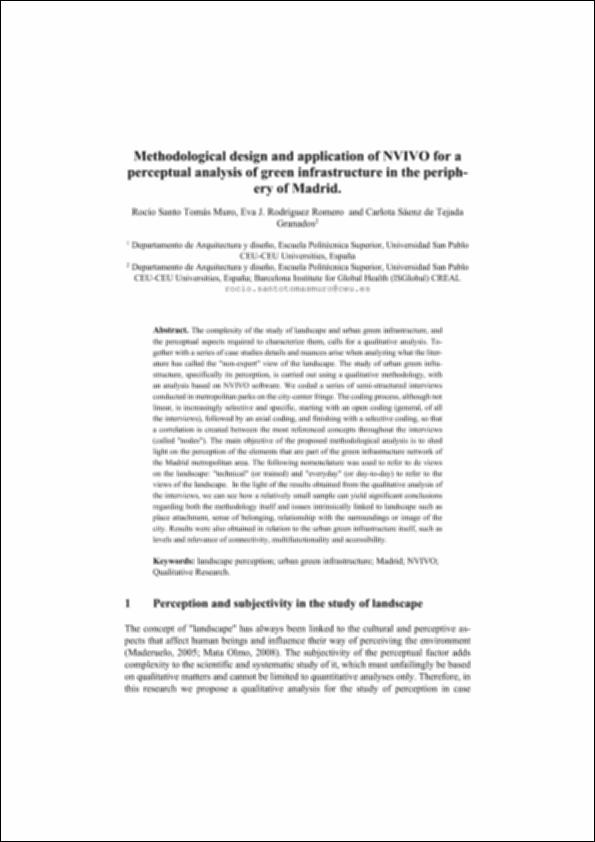Please use this identifier to cite or link to this item:
http://hdl.handle.net/10637/14319Methodological design and application of NVIVO for a perceptual analysis of green infrastructure in the periph-ery of Madrid
| Title: | Methodological design and application of NVIVO for a perceptual analysis of green infrastructure in the periph-ery of Madrid |
| Authors : | Santo-Tomás Muro, Rocío Sáenz de Tejada Granados, Carlota Rodríguez Romero, Eva Juana. |
| Keywords: | Landscape perception; Urban green infrastructure; NVIVO; Qualitative Research |
| Publisher: | Springer, Cham |
| Citation: | Santo-Tomás Muro, R., Rodríguez Romero, E.J., Sáenz de Tejada Granados, C. (2022). Methodological Design and Application of NVIVO for a Perceptual Analysis of Green Infrastructure in the Periphery of Madrid. In: Costa, A.P., Moreira, A., Sánchez‑Gómez, M.C., Wa-Mbaleka, S. (eds) Computer Supported Qualitative Research. WCQR 2022. Lecture Notes in Networks and Systems, vol 466. Springer, Cham. https://doi.org/10.1007/978-3-031-04680-3_6 |
| Abstract: | The complexity of the study of landscape and urban green infrastructure, and the perceptual aspects required to characterize them, calls for a qualitative analysis. To-gether with a series of case studies details and nuances arise when analyzing what the liter-ature has called the "non-expert" view of the landscape. The study of urban green infra-structure, specifically its perception, is carried out using a qualitative methodology, with an analysis based on NVIVO software. We coded a series of semi-structured interviews conducted in metropolitan parks on the city-center fringe. The coding process, although not linear, is increasingly selective and specific, starting with an open coding (general, of all the interviews), followed by an axial coding, and finishing with a selective coding, so that a correlation is created between the most referenced concepts throughout the interviews (called "nodes"). The main objective of the proposed methodological analysis is to shed light on the perception of the elements that are part of the green infrastructure network of the Madrid metropolitan area. The following nomenclature was used to refer to de views on the landscape: "technical" (or trained) and "everyday" (or day-to-day) to refer to the views of the landscape. In the light of the results obtained from the qualitative analysis of the interviews, we can see how a relatively small sample can yield significant conclusions regarding both the methodology itself and issues intrinsically linked to landscape such as place attachment, sense of belonging, relationship with the surroundings or image of the city. Results were also obtained in relation to the urban green infrastructure itself, such as levels and relevance of connectivity, multifunctionality and accessibility. |
| Description: | Este artículo es la versión pre-print de la publicación final |
| URI: | http://hdl.handle.net/10637/14319 |
| Rights : | http://creativecommons.org/licenses/by-nc-nd/4.0/deed.es |
| Issue Date: | 5-May-2022 |
| Center : | Universidad San Pablo-CEU |
| Appears in Collections: | Escuela de Politécnica Superior |
Items in DSpace are protected by copyright, with all rights reserved, unless otherwise indicated.


